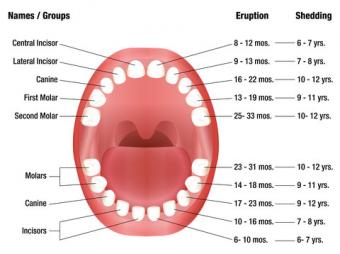
A child develops 20 teeth that generally start sprouting at about six months of age. All those 20 teeth will fall out naturally by the time they are teens. Learn how many teeth kids lose, why teeth fall out, tips for handling tooth loss, and when you should worry.
Growing and Losing Teeth: The Beginning
According to KidsHealth, a typical child has 20 primary, or baby teeth, and will lose them all. Before diving into the loss of teeth, it's essential to explore their development. A fetus starts developing teeth at about six months gestation. However, you won't see any teeth pop out until your baby is about six months-old. Generally, the bottom front teeth come in first, according to KidsHealth.
When Teeth Start Falling Out

By the time they reach age three, most kids have their full set of primary teeth. There are ten teeth in the upper part of the mouth and ten in the lower part. KidsHealth says these baby teeth start falling out around age five or six. The first ones to come in are the first ones to fall out, starting with the upper and lower front teeth. Get the camera ready for those gappy grins.
How Many Teeth Should a Kid Lose and When?
While each child's 20 teeth fall out at different rates, the American Dental Association (ADA) suggests kids lose about two teeth per year between ages five and twelve. The average number can be more or less per year, depending on the child. Just as some babies' teeth erupt at different ages, some kids' teeth get pushed out later than others.
Why Teeth Fall Out
When children's teeth fall out naturally, it follows typical child development and serves an intrinsic purpose.Dr. Mohamed Tarek, BDS, MFDS RCSEd says there are two main reasons people have two sets of teeth.
- The first is that babies have smaller jaws than adults, so their mouths simply can't hold the 32 secondary teeth needed later in life.
- The second reason is babies drink their mother's milk and eat soft foods, so they don't have a great need for big strong teeth to chew different tough textures.
Typical Order of Lost Teeth
Just like anything else in life, teeth have an order to them. They typically come in and fall out in a similar fashion.

Children's Hospital of Wisconsin shares a standard order in which primary teeth fall out; it coincides with the Permanent Tooth Development chart from the ADA.
- The first to go are usually the central incisors. These are the two front teeth on the top and bottom of a child's mouth.
- Lateral incisors are directly next to the two front teeth on top and bottom and fall out next.
- The second and third teeth from the back of the mouth, first molar, and canine, respectively, come loose around age nine or ten.
- A child's second molar is often the last one to fall out. These molars are the furthest back on both sides of the top and bottom of a kid's mouth. These get loose around the age of 12.
Tips and Tricks for When Teeth Start Falling Out

Baby teeth work to guide the adult teeth into place. Help your littles get their teeth out with a few tricks.
- Allow kids to wiggle their loose teeth to help them come out.
- Put a warm cloth on the face for pain.
- Don't force the tooth out. Let nature take its course.
- Have kids eat chew hard foods like carrots and apples to help a loose tooth out.
- Make losing teeth fun, so it doesn't cause anxiety.
- Remember, all kids lose their teeth in their own time.
How Permanent Teeth Erupt

Although most kids lose their primary teeth by age twelve, adults don't have all 32 of their permanent teeth in place until about age 21, says the ADA. Each baby tooth is pushed out by a permanent tooth erupting, which only accounts for 20 teeth. After secondaries replace primaries, bicuspid and third molars emerge.
When to Worry About Your Child's Teeth
Because tooth development happens at an individual rate, it can be easy for parents and caregivers to worry there might be a problem. Dentists from Boise Family Dental Care share several signs you may want to have checked out by a dentist when your child is at the appropriate age to be losing teeth.
- A permanent tooth is visibly erupting in front of or behind a baby tooth, but the baby tooth is not loose at all. In this case, the new tooth will erupt in the wrong position, and the primary tooth may need to get pulled.
- Other permanent teeth are crowding the area a new tooth is trying to erupt through, causing it to push through incorrectly or not at all. If the permanent tooth can erupt, braces may be able to help correct the issue later on.
- A baby tooth has not fallen out, and it is past the standard age for that tooth to fall out. This could mean the permanent tooth underneath never developed, and your child may need to keep the baby tooth forever.
Call the Tooth Fairy
When it comes to the simple question, how many teeth do children lose? The answer is 20. In fact, for many kids, losing their teeth signifies growing up and maturing. These special occasions are marked with visits from the tooth fairy and trips to the dentist. Knowing what to expect in terms of tooth loss helps parents and kids prepare for this normal growth stage.







